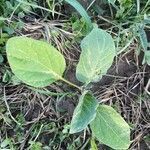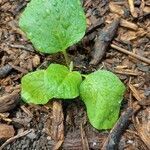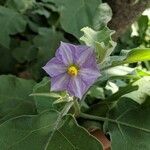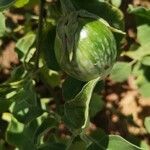Large perennial herb to 60 cm tall; twigs loosely tomentose with whitish, sessile and stalked porrect stellae, sometimes glabrescent, rarely armed. Leaves large, to 25 cm long, ovate, pinnatifid-lobed to subentire, the margin sinuate, apically acute, basally cordate, truncate or narrowed, often dimidiate, above dispersed to densely pubescent with mostly sessile, porrect stellae, beneath more densely pubescent; the petioles to 6 cm long, loosely pubescent. In-florescence a short, few-flowered, sessile or peduncled cincinnus, the first flowers functionally staminate, a few later flowers perfect; pedicels 1-2 cm long, tomentose, sometimes articulating near the base, longer and much stouter in fruit. Flowers with the calyx ca. 12 mm long, lobed about halfway, the lobes lanceolate, tomentose outside, glabrous within except at the tips, accrescent and splitting irregularly in fruit; corolla mauve, 3.5-5 cm across, lobed halfway with short teeth in the lobes; stamens free, the filaments 3-4 mm long, broader at the base, the anthers ca. 6 mm long, stout, dorsally flattened; ovary densely stellate on top, glabrescent, the style densely stellate below, less so above, the stigma of 2-4 small discoid lobes. Fruit very large, to 40 cm long, ellipsoid or ovoid with a thick rind and moist, firm pulp, purple-black (Panama), ultimately turning yellow, rose, green or brown.
More
Herbs or subshrubs to 60 cm tall, sparingly armed, pubescent with stellate hairs. Stems and branches minutely tomentose, sometimes with stout recurved prickles. Petiole 2-4.5 cm; leaf blade ovate to oblong-ovate, 6-18 × 5-11 cm, stellate-tomentose or sometimes with a few fine prickles on both surfaces, denser abaxially, base oblique, margin sinuate-lobed, apex obtuse. Inflorescences mostly solitary flowers, rarely reduced racemes; peduncle obsolete. Flowers andromonoecious. Pedicel 1-1.8 cm. Calyx stellate tomentose, often with ca. 3 mm prickles abaxially; lobes lanceolate. Corolla purplish or violet, rotate, 3(-5) cm; lobes deltate, ca. 1 cm. Filaments ca. 2.5 mm; anthers ca. 7.5 mm. Style 4-7 mm. Berry black, purple, pink, brown, or yellow, yellowish when completely mature, greatly variable in form and size, mostly more than 6 cm in diam., with a thick, spongy, whitish mesocarp and septal region. Seeds lenticular, yellowish, 2.8-3.9 × 2.5-3.5 mm.
A perennial shrubby herb up to 1 m tall. It is often grown as an annual. It has a deep taproot and branched side roots. The stem is thick and covered with many woolly hairs. The plant has many branches. Often the plant is spiny. The leaves are large, alternate and simple. They are angular and unequal near the stalk. Leaves can be 20 cm long and wavy along the edge. Leaves are covered with hairs. Flowers are bluish red and 5 cm across. They are either solitary or in small groups opposite the leaves. They have 5 large woolly lobes which continue to surround the base of the fruit. Fruit are white, blue, green or purple. The fruit colour and shape vary. Sometimes the fruit is spiny. Often the fruit are 10 to 20 cm long and 5-8 cm wide. Numerous kidney shaped seeds are in the flesh of the berry. There are many cultivated varieties.
A tropical plant. A plant of the warm tropics. Plants grow from sea level up to 2200 m altitude in the tropics. It suits wet climates but does well in dry climates with irrigation. It needs a long warm growing period. A daily mean temperature of 20-30°C is most suitable. They are frost tender. They need a rich, friable, well tilled soil. In the subtropics they can be grown as a summer crop. In Nepal plants grow to 1500 m altitude. It suits hardiness zones 9-12.
Fruit are mostly fried then eaten. They can also be grilled, baked, stuffed and stewed. They are used in curries. The fruit are also dried and stored. The leaves although edible are hairy and not good flavour. They are mixed with rice bran and salt in which Japanese radishes are pickled.








